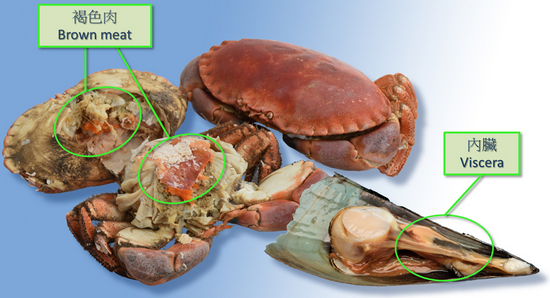
Food Safety Focus (133rd Issue, August 2017 ) – Food Safety Platform
Cadmium: A Metallic Contaminant of Major Public Health Concern
Reported by Ms. Janny MA and Ms. Joan YAU, Scientific Officers,
Risk Assessment Section,
Centre for Food Safety
To recap, cadmium is one of the four metallic contaminants identified as of major public health concern by the World Health Organization. In this article, let’s find out more about cadmium and explore ways to reduce its exposure from various major food sources as revealed from the local Total Diet Study.
Health Effects
Acute toxicity of cadmium due to dietary exposure is very unlikely. The kidney is the critical target organ in terms of chronic toxicity. Cadmium accumulates mainly in the kidneys and may lead to irreversible kidney dysfunction. High intake of cadmium can also lead to disturbances in calcium metabolism and the formation of kidney stones. In addition, softening of the bones and osteoporosis may occur in those exposed through living or working in cadmium-contaminated areas.
The International Agency for Research on Cancer considered that there was sufficient evidence of carcinogenicity of cadmium and cadmium compounds in humans upon occupation exposure and classified them as Group 1 agent, i.e. carcinogenic to humans. Nevertheless, cadmium did not appear to have significant genotoxic and carcinogenic potential via the oral route.
Local study revealed that the dietary exposure to cadmium of the local population fell below the health-based guidance value (HBGV) (the dietary exposures of average and high consumers of the population accounted for 33% and 75% of HBGV respectively), indicating that the general population was not at risk due to cadmium. HBGV is an estimate of the amount of a chemical that can be ingested over a defined time period without appreciable health risk.
Cadmium in Our Diet
Cadmium contained in soil and water can be taken up by certain crops and aquatic organisms and accumulates in the food-chain. The major dietary sources of cadmium are “vegetables and their products”, “fish and seafood and their products” and “cereals and their products”, which contribute to 36%, 26% and 21% of the total exposure respectively.
Vegetables
The presence of cadmium in vegetables may be due to the absorption of cadmium through the roots. Atmospheric fall-out will also contribute to the content of cadmium, especially for leafy vegetables. In general, cadmium accumulates in the leaves of plants and therefore higher level of cadmium may be found in leafy vegetables such as spinach. In addition, some wild edible fungi may also contain high levels of cadmium.
We should all note that adequate amount of vegetable intake is an essential component of healthy eating. Maintaining a balanced diet with a variety of leafy and non-leafy vegetables can avoid excessive exposure to cadmium from a small range of food items. In addition, washing of vegetables and peeling of roots and tubers can reduce cadmium contamination to some extent.
Seafood
Crustaceans are natural accumulators of cadmium. The Centre for Food Safety Food Surveillance Programme had previously found some crab samples, in particular brown crabs, containing high levels of cadmium. Overseas and local studies have shown that levels of cadmium in the muscle meat of crab claws and legs (commonly referred to as white meat) are low but those in the brown meat (including gonads, liver and digestive glands) can often be higher (see Figure). To reduce the risk, people who consume more crabs, particularly brown crabs, are advised to limit or avoid the consumption of brown meat.

Brown meat (including gonads, liver and digestive glands) in brown crabs and viscera of scallops may contain higher levels of cadmium.
Being filter-feeders, cadmium, like other contaminants, is concentrated in viscera of molluscs such as oysters and scallops. To minimise the associated risk, over-indulgence in shellfish consumption should be avoided. Viscera of scallops should also be removed before cooking and only the adductor muscles should be consumed.
Fish normally contain lower levels of cadmium.
Cereals
Due to the high consumption, cereals including wheat and rice as well as their derived products are one of the major dietary sources of cadmium in the local population. Cadmium can mainly be found in the outer parts of the grain, which are wholly or partly removed in the milling process. Nevertheless, consumption of whole grains is generally recommended as part of a healthy diet due to the presence of important nutrients such as dietary fibre. All in all, it is essential to take a balanced and varied diet.
What’s Next?
In the next article, let’s have a look on the metallic contaminants in a specific food commodity, i.e. edible fungi.


